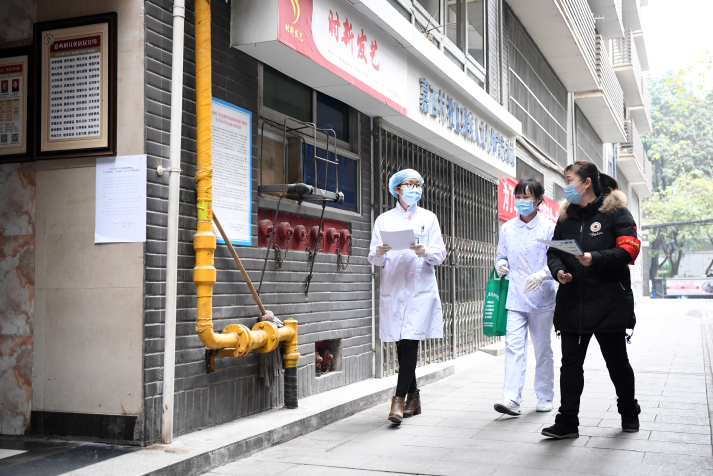|
||||||||||
| Home Nation World Business Opinion Lifestyle ChinAfrica Multimedia Columnists Documents Special Reports |
|
||||||||||
| Home Nation World Business Opinion Lifestyle ChinAfrica Multimedia Columnists Documents Special Reports |
| ChinAfrica |
| Anatomy of an Epidemic |
| Veteran public health expert analyzes development, future trend of COVID-19 |
| ChinAfrica | VOL.12 April ·2020-03-30 |

Liu Yuanli
Since the outbreak of COVID-19, Liu Yuanli, Professor and Dean of the School of Public Health at the Chinese Academy of Medical Sciences & Peking Union Medical College, has been providing suggestions on scientific prevention and control of the epidemic.
A domestic team of researchers led by Liu closely monitored the epidemic prevention and control in Hubei Province and the whole country, and put forward effective and operational policy recommendations. His overseas team paid close attention to the international epidemic trend, the latest relevant scientific research results, and international experience that can be used for reference.
Liu previously did research and teaching in international health policy and management at Harvard University for nearly 20 years. As one of the founders of Health Systemology, Liu talked about the importance of science-based understanding of the epidemic, the possibility of preparing for a protracted fight, and the Chinese public health and medical system in an interview with Caijing magazine in early March. An excerpt of his views follows.
A novel challenge
Compared with SARS in 2003, the transmissibility of COVID-19 is much stronger, and about 80 percent of the infected people have only mild symptoms or no symptoms during the incubation or recovery period. Although the mortality rate of COVID-19 is not as high as SARS, the clinical manifestations are very complicated, affecting multiple organs and systems, including the respiratory, blood and circulatory systems.
From a historical perspective, COVID-19 is a major public health emergency that occurred in China with the fastest spread, the widest range of infections, and the most difficult prevention and control challenge since the founding of the People's Republic of China in 1949.
The effective response to any public health emergency is a race against time. The disease must be detected in time, followed by a quick response. Moreover, the country also must take appropriate measures. It is true that whenever a new infectious disease appears, there are many uncertainties about what the pathogen is, how it is transmitted, and how toxic and contagious it is, but previous experience has repeatedly reminded us that we should deal with it as soon as possible. At the same time, we must communicate with the public in a timely and frank manner, and remind all parties to take the necessary actions early to prevent the worst outcome.
Traditional Chinese medicine (TCM) is a huge treasure house. Artemisinin, for example, which has helped save the lives of millions of malaria patients, can serve as a model. At present, there is no specific medicine for the treatment of COVID-19, and given the fact that patients mainly rely on their immune system, we should pay more attention to the role of TCM based on a holistic view.
We are pleased to see that the National Health Commission of China has included TCM into the treatment of COVID-19 since the third edition of COVID-19 diagnosis and treatment plan. This will not only bring good news to many domestic patients, but also benefit more and more members of a community of shared future for mankind.
Awareness and preparation
Statistics show that worldwide, the interval of mutant influenza virus infections has shortened from 10-40 years before the 1970s to about five years in the 1980s. After the 1990s, mutant influenza virus infections have occurred every two years.
In just the first two decades of the 21st century, we have witnessed several pandemics of viral infections such as SARS 2003, influenza A (H5N1), influenza A (H1N1), influenza A (H7N9) and COVID-19. Therefore, we need to be prepared to constantly respond to the challenge of emerging infectious diseases, both domestically and globally. This is the new normal of epidemic prevention and control.
There are two possibilities for the future trend of COVID-19. One is the situation we all want, that is, the virus, like SARS 2003, will eventually disappear at a certain period of time. There is also the possibility that the virus will persist, intermittently, in local epidemics.
Therefore, we need to make preparations for a "protracted war" and actively cope with challenges in two aspects: one is coordination on technical support for orderly resumption of work, production and reopening of schools; and the other is the coordination of domestic and foreign epidemic prevention and control efforts, further expansion of international exchanges and cooperation, and shouldering the responsibilities of a big country.
China's rapid and strong response to the epidemic has won precious emergency preparation time for all countries in the world. In addition, China has shared the gene sequencing results of COVID-19 with international peers on time, so that the world can start to develop vaccines and drugs as soon as possible, which can be of great help in avoiding the worst-case scenario.

Family doctors and a community worker visit residents who have signed contracts with the doctors in Chongqing on March 7. Family doctors have been a great help in containing the spread of the virus during the COVID-19 epidemic (XINHUA)
A big test
After the outbreak of the epidemic, China took coordinated prevention and control measures. More than 40,000 medical personnel organized into 330 medical teams have been transferred to Hubei Province, the epicenter of the outbreak, among them over 15,000 specialize in critical care medicine, infectious diseases, respiratory medicine, cardiovascular medicine and anesthesiology.
After more than one month of relentless efforts, China has seen remarkable results of these measures.
At the same time, this big test of the epidemic has also exposed some shortcomings of our public health emergency system. Since the SARS epidemic in 2003, the country has devoted a lot of manpower and material resources for establishing an infectious disease online direct reporting system. But it seemed that the monitoring and early warning was not effective at the early stage. Does China urgently need to establish an intelligent epidemic surveillance system based on cross-industry, multi-source information, big data and artificial intelligence? How to make clear divisions of the duties and roles of professional public health and medical institutions and those of the government and non-professional social organizations during the response to emergencies? How to provide more and better personnel support and guarantee for the modernization of the epidemic prevention and control system? These are issues that need our consideration.
Reform on the way
Since China's reform and opening up more than 40 years ago, the process of health care system reform can be roughly divided into three stages, focusing on three sets of challenges.
In the early stage from 1978 to 1997, the main problem was the lack of doctors and medicines. In the second stage from 1998 to 2008, the medical cost grew rapidly, and the health insurance was underdeveloped. In the third stage from 2009 till present, the country has carried out a new round of medical system reform, aiming to solve problems such as the difficulty in the access to medical resources and high medical cost of the people.
Currently, we still have some problems, such as more emphasis on treatment compared to prevention; low proportion of public health expenditure in total medical and health care expenditure, and shortage of public health professionals. The COVID-19 epidemic highlights the importance and urgency of strengthening the construction of China's disease control system, the development of the system's professional and administrative functions, and further implementing the integration of prevention and treatment.
In the future, it's necessary to increase investment in public medical and health institutions and establish state-level public health centers in several regions, including departments to deal with new infectious diseases. At the same time, we should give full play to the role of community-level medical and health institutions, family doctors and various professional societies and associations in the medical field.
(Comments to zanjifang@chinafrica.cn)
| About Us | Contact Us | Advertise with Us | Subscribe |
| Copyright Beijing Review All rights reserved 京ICP备08005356号-5 京公网安备110102005860号 |